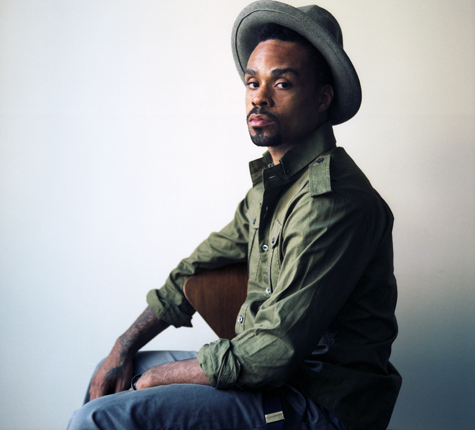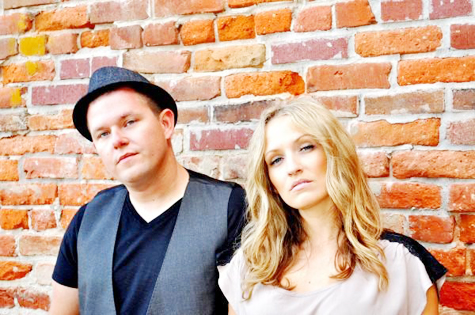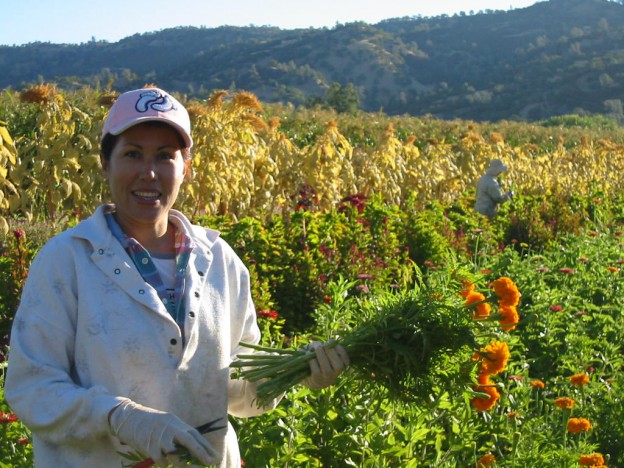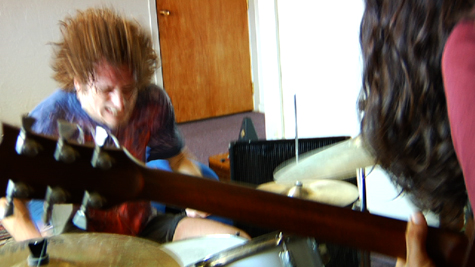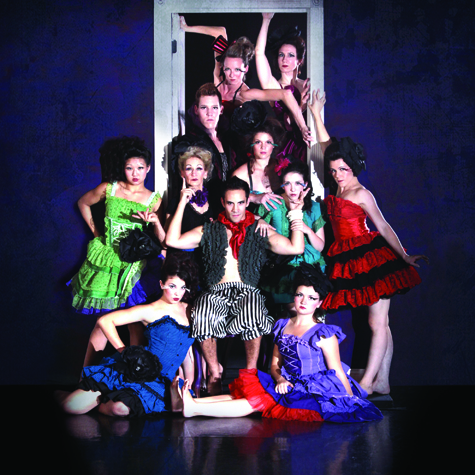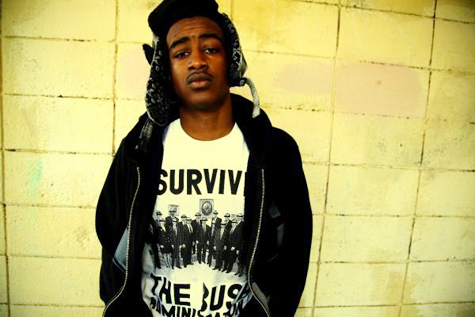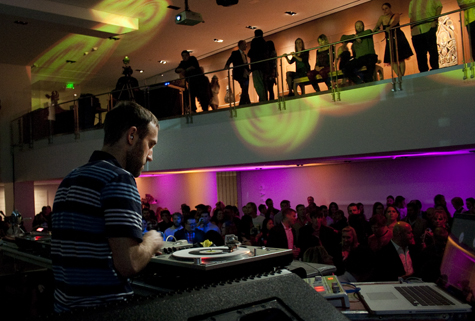Soul singer/songwriter Bilal comes back with a vengeance after a lengthy absence
Born in Philadelphia in 1979, Bilal Oliver was immersed in music at a young age. As if through osmosis, he absorbed the energy of the jazz and soul greats that paved the roads he roamed, studying the sounds and applying them as he saw fit. Educated in the arts, he nurtured his dream into a reality and by the time he was 21 already had heavyweights like Dr. Dre and Raphael Saadiq in his corner. His debut released in 2002 was met with resounding praise, but fate took a turn when his followup Love for Sale was leaked, then shelved, eventually resulting in Bilal parting ways with what he had worked so hard for.
The sudden left in his life may have been the right move, as almost a decade after his debut he has pieced together his most creative and liberating piece of work. Airtight’s Revenge (a mark of triumph over the leak) finds Bilal playing the role of the alchemist; blending genres, cross-pollinating sounds and burrowing his way into his own niche. The only constant is the signature voice, and the conviction from which it comes. Read on, and bare witness Oct. 24, 2010 at Dream Nightclub.
I understand early on you learned to recreate Miles Davis and other jazz cats’ songs with your voice. Was that something that you just took to, or did someone hip you to that?
My friends in high school were jazz musicians, and we would always scat all the tunes, that’s just how we would do it. It intrigued me, and then I realized all the great jazz musicians like Dizzy Gilisepe and Satchmo did it, so I followed that.
Hip-hop at this time was getting really big in the United States. Did you ever go through a rapping phase or did you always stick to singing?
I went through a little of a rapping phase. My name was… It was a while ago, but it wasn’t anything serious.
Did I hear you start to say you had MC name?
Yeah, I wasn’t going to disclose that [laughs]… I changed my mind. MC Think [laughs].
From being a kid to teenager, you were signed when you were 19. How have your goals changed since then?
Well, I always knew I wanted to have a band and make music. That’s always been my dream since high school, and it’s all come to fruition. This is my career. I’m making a living off of doing this, so I think I’m living that.
It has to be different musically now on this go-around.
When I was signed to a bigger label, the whole catalyst was to make this one big single that would blow up. I used to say, “Man, I wish I could just make music and not really focus on making that one single.” After a while your whole album starts to sound like that “one big single.” Now, I’m in a situation where they allow me to just make music. I’m able to do a lot more. I went back to the singer/songwriter thing I was starting to do on Love for Sale. I played keyboard on all but two songs, and I wrote them all from piano, so I got to play a lot more.
I heard an interview where you were talking about how you took two years off from music after the Love for Sale situation. You were talking about how you were hanging out with a painter, and how he referred to himself as a musician so that he wouldn’t have the pressure of being a great painter, and how you then in jest called yourself a painter on the flip. Is there a painter you find parallels with as a musician?
I would say someone in the angle of Salvador Dali. He was very skilled, but he mixed everything up and stretched it out and mutated to an obscene level to where it was something new. He knew how to draw appropriately, but he painted so inappropriately. He made his own way. He had the technique to do whatever he wanted to do, and he was just out there.
Yeah, being out there artistically speaking, can be difficult in the major label world. I assume you had people trying to change what you were doing?
Yeah. I went through that. With my last situation, it came up a lot. It was never you have to be like this, but you gotta dumb it down a little bit so people can understand that. I’ve heard that before.
In those words?
Yes [laughs]. “You gotta dumb it down,
people are idiots.”
Without going through that two-year period, do you think you could have made an album like this or was it critical to Airtight’s Revenge?
It was absolutely a critical time. I felt like I was making really contrived shit, so I had to stop and reevaluate things. Whenever I feel like I’m going in circles, I try to find the root of it again. The way you find the root is to dig. I just stopped what I was doing and took a step back from it all for a minute and didn’t really think about it. That was crucial; it was my detox.
I know you worked with Chuck Treece, who was affiliated with Bad Brains. Was his influence something new for you?
Yeah man, Chuck Treece. He really opened me up on this record. Playing with Chuck put me up on a lot. I got into Bad Brains a little in high school, but I got into Ahmir’s [?uestlove of The Roots] collection and found stuff like I Against I and, whoa. After that, I got the whole catalog. I had known Chuck for like 10 years. I met him when I was singing in D’Angelo’s band. When I met him he was playing guitar, but he was also playing drums for a minute with Bad Brains so that just tells you what kind of musician he is. We started jamming out, and shoot, he’s just a monster. But yeah, it taught me how to play with a certain ferocity and simplicity. Simplistic, but I still put my jazz inflections in there. I’m always trying to make the complex simple, in a complex way. Sorta like espresso. Make it a little more potent, but simple at the same time. Like James Brown did with the funk.
And like Dali did with the painting.
Yup [laughs].
Local acoustic/country/folk duo Attwater released their first album, titled Live at Harlow’s, for free online last Tuesday. As the title suggests, the album was recorded live at Harlow’s in downtown Sacramento on Oct. 3, 2010. The great thing about live recordings is there is nowhere for the musicians to hide; mistakes can’t be edited out or overdubbed. Jonathan Richards and Erika Attwater thrive in the live setting and it clearly shows. Attwater’s vocal performances are goosebump-inducing and Richards’ clean guitar playing and vocal harmonies round out their honed sound extremely well. The two have been playing as much as possible around town the last few months at venues like Fox & Goose and Marilyn’s on K, earning rave reviews from venue owners and patrons alike. The two will head into the studio within the next month to record a single with a full band; after that, they’re planning on releasing an EP and touring. To get Live at Harlow’s for free, head to www.noisetrade.com/attwatermusic or catch them on Oct. 29, 2010 at Naked Lounge, Oct. 30, 2010 at Global Cafe in Roseville or Nov. 11 at Fox & Goose.
Full Belly Farm
Road 43 – Guinda, Calif.
Crossbred stone fruit has been a high for foodies these days. Apriums, tomato plums, necterlums and the like have spurred interest and curiosity in Sacramento.
While perusing the produce section of the Sacramento Natural Foods Co-op last week, I had an eye out for new fruit mixtures like the plumarines I saw a few weeks prior.
Although there were no “new” fruits, a large presence of summer produce not yet saturating the farmers market scene prevailed. Long, thin, furry-skinned Armenian cucumber and various melons like Galia, Charentais and Ambrosia were prominently presented. Next to each, a little laminated card explained their local origin from “58 miles” away at Full Belly Farm in the Capay Valley.
Much like many an urbanite, relishing farmers market visits as actively connecting to my food source was as close to the farm as I got. The idea of farm forays was too rural for my metropolitan mindset; therefore, I’d never seen where local produce is grown or how it’s processed for shipping the short distance to Sacramento.
I had questions like, “What’s special about this farm?” and “Why is our Natural Foods Co-op featuring so much produce from this farm?”
Produce manager Kerri Williams cleared some confusion, explaining the Natural Foods Co-op’s organic produce, featured local farms, and relationship with Full Belly Farm.
With the largest 100 percent organic produce section in the United States, the Sacramento Natural Foods Co-op insures most of its produce is local–within 200 miles, Williams said. At least 80 percent of farms providing produce for Co-op shoppers are within those parameters, she said.
Full Belly Farm has held produce realty at the Natural Foods Co-op for “at least 25 years.” Certified organic in 1985, this farm was an organic staple at the Natural Foods Co-op for 13 years before the produce section made the switch from conventional to organic, Williams said.
Aside from obvious health benefits, my interest in organic produce is barely beyond skin-deep. Call me a superficial shopper, but the true-fruit smell and appearance of organic produce always attracts me. Since organic produce usually tastes better, fresher, more of earth-grown goodness, I definitely judge produce as I initially do books: by the cover.
Speaking of beauty, Williams said aside from featuring most of Full Belly Farm’s crop, “It’s also the most beautiful of area farms.”
Fifty-eight miles seemed like a world away and the Capay Valley was a place I’d never heard of. I needed to see this farm for myself and made the produce pilgrimage to Guinda, Calif.
As it is busy season for farming, I called and made an appointment to visit.
The hour-drive northwest from Midtown was interesting. After passing Woodland and Cache Creek Casino and coasting into the gorgeously narrow Capay Valley, I lost cellular reception minutes before turning right on Road 43 into Full Belly Farm.
It was mid-afternoon and the sun was splashing down the steep hills of the valley, pooling over the farm. Co-owner Judith Redmond greeted me as I walked into a thankfully shadowy barn-like structure. Circle-spectacled and wide-smiled, Redmond spoke warmly but informatively with me about various types of produce, while particularly hand-packing fragrant, multi-colored heirloom tomatoes into cushioned cardboard boxes.
To understand said mixed fruits, Redmond explained hybrid and crossbred produce.
Produce is hybrid to preserve a specific quality like color, low-fuzz skin, growing capacity in certain agricultural circumstances or shipping, Redmond said.
Local farmers grow tons of crossbreeds, and have for decades, practicing on-site agronomy to see what “flourishes in their geographical location.”
“Farmers are trying to take back their rightful place as stewards of plant-growing resources,” Redmond said.
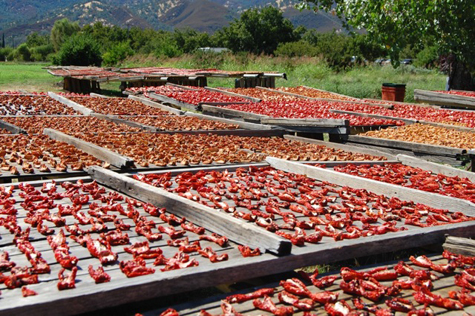
Saving the items with the most desirable qualities, hybridizing is a seasons-long process. And hybrid produce are the end of the line genetically–their seeds won’t produce more with like characteristics, Redmond explained.
Although unpredictable, hybridization and cross-pollination can occur in nature, both agronomy practices can be accomplished in a scientific lab. Farmers can also manually cultivate hybrid produce and facilitate cross-pollination, but the process is expensive, drawn-out and unsuccessful, Redmond said.
Full Belly grows hybrid varieties of white sweet corn, slicer tomatoes and yellow watermelon, but Redmond said she also sees occasional cross-pollination in crops like white corn and decorative corn grown in a neighboring area of the farm.
When fruits are crossbred, the process includes taking two similar fruits and cross-polinating them. Stone fruits are often crossbred, Redmond said. Melons seem apt to crossbreeding as well, with honeylopes and Crenshaw melons available among others.
Although not specializing in crossbred produce, Full Belly is beyond beautiful with lush, green, cared-for crops receiving all the glory of the sun funneling down upon it.
With permission, I walked the grounds freely and smiled as wide as Redmond in reaction to the nourishing colors, fragrances and favorable environmental factors. I saw happy cultivators, quaint structures, par-dried peaches and tomatoes actually drying in the sun and happy cows feasting on heirloom tomatoes (cows like tomatoes, I guess).
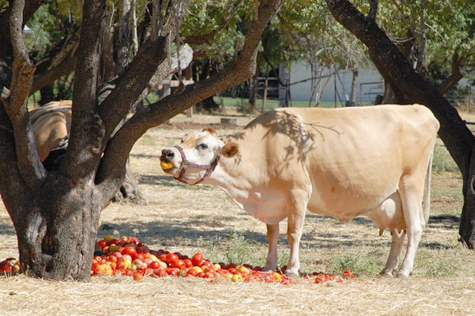
Summer’s sweet batch of produce has been cheered and devoured for months, but we’re just getting into the thick of it, equating the perfect time to shop, eat and learn about the power of local produce.
A great opportunity for a daycation, beautiful drive and farm-visiting experience is coming up on Oct. 2 and 3, 2010 for the 23rd annual Hoes Down Harvest Festival at Full Belly Farm. There’ll be workshops, music and food. Farms aren’t just for agricultural buffs and gardening grandmas; food-savvy urbanites can benefit too.
DJ Shaun Slaughter Talks his Trade as Lipstick Turns 10
Words by Adam Saake – Photo by Matthew Burks
A jazz album plays in the background of Shaun Slaughter’s Midtown apartment as I sit down to discuss the 10-year anniversary of Lipstick, his indie dance club at Old Ironsides here in Sacramento. I guess maybe I expected a Phoenix song to be playing, or something along those lines, but then it all makes sense.
“I don’t want to have to play ‘1901’ ever again,” says Slaughter, half-joking. “I love that song, but I love it so much that I don’t want to play it so I don’t ruin it for myself.”
It’s like making burritos all day: you don’t hate burritos you just don’t want to have one right when you get off work. Alright, bad comparison. Indie rock isn’t really like burritos. But imagine for a second that Slaughter and Lipstick-partner-in-crime, Roger Carpio, are the tortillas. Wrapped up inside of these two musical encyclopedias is a plethora of songs that each have dug up from the depths of record bins and music blogs to play for a finicky crowd, week after week, year after year. Maybe you can’t eat Mexican food every day, but many faithful Lipstick-goers show up damn-near every Tuesday to see what the boys have drummed up now.
It wasn’t always as packed as it is these days; it was a bit of slow climb. And in the beginning it wasn’t always just Slaughter and Carpio. The original Lipstick lineup consisted of four DJs who all had very different ideas about how the night should sound. But what unified them was one simple idea–make them dance.
Slaughter was friends with a fellow house-head named Chad Nardine. Both he and Slaughter were new to downtown. Slaughter himself was a kid from the suburbs and barely 21, and they were given a slot at the Press Club to DJ. They cut their teeth there for a while but frustrations with the manager and too many randoms walking in requesting Madonna had them looking elsewhere. They were then approached separately and asked to DJ at Old Ironsides on one fateful Tuesday. Realizing they had both been solicited for the same gig, they of course decided to do the night together.
“Our first Tuesday ever was just Chad and I, and it was all electronica and it bombed,” says Slaughter. “No one was there!”
The two needed to revamp, so they went back to the drawing board to figure out how they were going to put together a better club night that would hit. The two of them were growing tired of DJing dance music and Slaughter had a taste for older alternative rock like the Rentals, Weezer and Sonic Youth. Nardine picked up on this and told Slaughter about Carpio.
“Chad said, ‘I have this friend named Roger who’s really into Britpop,” recalls Slaughter. “And I had no idea what that even meant.”
Carpio added his own ideas to the sound of the night and each peppered in their unique styles. To round out their indie rock dance night, Roger brought one more DJ into the mix.
“Then Roger said, ‘I know this guy Sean Meyers who DJs really good ‘60s rock.’ We heard him play this set one night, and it was just amazing. We added him on and then it was the four of us,” says Slaughter.
During that first year of Lipstick at the Press Club, the four played to lackluster response and were perfectly OK with that. The few that showed up showed support the best way a DJ could hope for.
“It was good, and we were happy with 30 or 40 people,” says Slaughter. “We couldn’t believe that people would dance to it.”
Nardine eventually ended up moving away and Meyers excused himself to pursue other endeavors. That left the two DJs, Slaughter and Carpio, who couldn’t have been more different from each other. But what at first may have seemed like a duo doomed to butt heads, disagree over music choice or altogether fail as partners ended up being the exact right pairing that would keep Lipstick running after all these years.
“We were both really particular about how the night went,” explains Slaughter. That’s why…it’s been around so long. Both of us were really stuck on the fact that it had to be a certain way.”
And that certain way was “some indie, Britpop and some old stuff” as well as no guest DJs. Whatever they were playing, they were doing something right and that mindset of sticking to a format was the foundation that drew in crowds night after night. Over time, though, the box they DJed inside of eventually proved to be too small and it was time for more legroom.
“I think that if we would have stuck with that, it would have just died out, because ultimately people don’t want to listen to the same stuff,” says Slaughter.
So again, what the two shared in common was what kept Lipstick new and interesting over the years. Their shared passion for discovering new music coupled with Lipstick happening every week made for the right motivation to keep introducing the dance floor to new bands.
“Roger and I are super avid. All we do is dig for music and listen to new stuff,” says Slaughter.
At times it can be “a double-edged sword” Slaughter says, hand on his chin and thoughts on his mind. Keeping the night always new and always changing is fun when you’re a DJ because you’re never playing anything out. You’re able to keep a song like “1901” for your own enjoyment. Yet, certain songs are guaranteed to pack the dance floor and in the end, isn’t that your job as a DJ?
“You’re doing people a disservice if you don’t play some of that stuff,” says Slaughter. “You do it every Tuesday and you’re thinking, ‘Fuck! I’ve heard this song so many times.’ But then I think about the people who haven’t been coming every week and how excited they are to dance to a song they’ve never heard before.”
It’s rare for anything in the music and art scenes to last 10 years, let alone a club night. People change, bars close, relationships go south. It’s just the way it is. For Lipstick to have endured 10 years on an ever-changing music scene and all the while under what seems like constant scrutiny from naysayers calling Lipstick a club night for “hipsters,” is pretty amazing. This common misconception is immediately squashed when you walk through the doors on any given Tuesday. It’s a shot in the dark as to whom you’re actually going to find inside at the bar. Most likely you’ll find those same naysayers who are socializing with the “hipsters” while buying shots for your introverted co-worker from the office.
“We’ve gone through so many waves,” explains Slaughter. “Roger is like, ‘Dude. How many times have we gone through this?’”
Maybe that’s why Slaughter and Carpio have stuck it out all these years. Keeping the crowd showing up is one thing, but keeping themselves interested is another. But when each year brings a new crowd, with new friends and more good times to add to the memories, it makes it easier to stick around. Plus, Slaughter and Carpio switch it up around town and have been behind the wheel of many other successful, and most importantly, just really fun club nights around Sacramento. One of their most popular nights, FUCK Fridays at the Townhouse Lounge, is their sort of alter egos where they can completely let loose. Here they promote a “let’s lose our shit and go completely crazy” attitude while Slaughter is dressed up as say, an M&M or a rat costume [pictured].
What people don’t always realize is that many DJs and promoters in Sacramento, including Slaughter and Carpio, have their finger on the pulse of what’s good in the music and club scenes around the country. Slaughter frequently travels to other cities to DJ, and when he returns he brings back with him the best ideas he’s encountered to apply to his own club nights. In the words of Slaughter, “We stole everything from somebody.” Although, I prefer borrowed, for what are ideas without inspiration?
“Everyone always thinks there is something better,” says Slaughter. “Compared to a lot of other cities, we’re actually doing pretty well. The nights we’re throwing are really current.”
Recently, Slaughter has been focusing his energy on the production side with a new project called D.A.M.B. that just got picked up by DJs Are Not Rock Stars Records. “Daylight,” his first track released, plays with samples of Harry Belafonte’s “Day-O” backed by a tropical house beat. His second track, “Waiting,” has already been remixed by the LOL Boys, Mom & Dad and Wolfie and has found its way around a number of high-traffic blogs. Not too bad for his first two tracks. We’ll see where it goes in the coming months, seeing as how Slaughter has his hands pretty full booking up-and-comers for FUCK, scouring the Internet for Lipstick and doing the graphic design for all his flyers. It’s a lot of work, but he’s managing to make a living doing what he loves.
“I’m definitely super, super happy. I could be playing Top 40 every night,” says Slaughter. “I get the privilege of DJing with Roger too, and I get to hang out and get paid to do something amazing. I think it’s insane that after 10 years people are still there.”
Here’s to another 10.
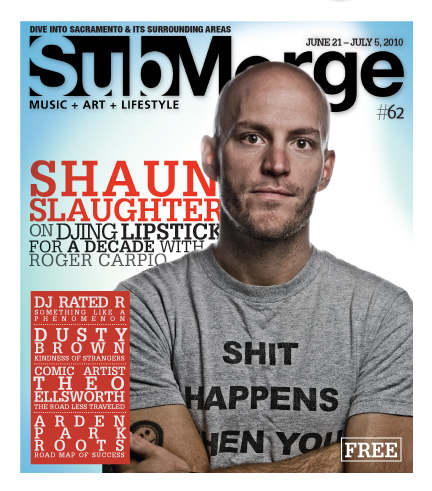
Check out Lipstick Tuesday nights at Old Ironsides. For more info, go to www.blasefaire.com.
Zach Hill discusses his new album and his Tao of Drumming
If Zach Hill is anything, he’s prolific. The definitive characteristic of his drum style is constant movement, an unrelenting source of rhythm. The list of musicians he has performed with extends across the globe. This year alone, his name will accompany a drum credit on five studio releases: Cryptomnesia by El Grupo Nuevo de Omar Rodriguez-Lopez, Ice Capped at Both Ends by Diamond Watch Wrists, by- from the duo Bygones, Aggressively Humble by CHLL PLL, and last but not least Face Tat by Zach Hill himself, scheduled for release Oct. 19, 2010. He plays drums for one out of six groups on Sargent House Records alone. And there are more recordings pending, the upcoming Hella record being one. Just to catch him for a conversation, Submerge had to squeeze two hours from his week-long break between a tour of South Korea and Japan with Carson McWhirter, and an Australian leg with the Boredoms he left for before we even went to press.
Hill is aware of the all this. “Not to sound pretentious, but I’ve released over 100 records,” he said. Self-taught, he’s become a financially independent musician. He states it simply, “I’m proud of most of what I’ve done.”
But to summarize his catalog is a superficial gloss of what Zach Hill is all about. Behind a quiet demeanor lies a restless mind, stirring constantly like so many endless drum fills. We talked mainly about the process of recording the new album and how his schedule creates a disruptive focus that enables him to participate in so many projects simultaneously. We also discussed the appealing qualities of an expressive live performance and improvisation. And then he left for Australia.
Face Tat is a fast-paced album full of hard-hitting drums and a million sounds that prove difficult to catalog. Multiple musicians aided Hill in his composition. “A lot of friends definitely contributed good amounts to the record,” says Hill. “Generally when I make my own records, there’s a lot of other people involved, writing, contributing musically. We record together and by the time they hear it I’ve changed it completely, in lots of different ways. Whether it was cut up or totally deconstructed or destroyed, I take whatever my friends have contributed and make it something different.”
This process, reworking the material parts and manipulating them into new sounds, is a consistent approach to Hill’s songs. In digital recording this could lead to endless editing, yet Hill has been able to stay focused. Many of the tracks have specific structures, which the guest musicians build upon, “It’s a specific idea or sound or part that I’ll ask a friend to play,” says Hill. “Or, I’ll play myself; I’ll already have a drum track, with the song entirely composed on drums, and I’ll have an idea of rhythmically and/or melodically what I want to happen. Or, I’ll be working with a series of samples of sounds that other friends contributed while they were playing with me and I’ll flip those and change them up. It’s a sound collage style, nontraditional. There’s a lot of diversity within the record. I’m excited about it.”
One exception to this process of recycling musical parts would be “Face Tat,” which is a duet of sorts between Hill and guitarist Carson McWhirter. A YouTube video is available of them recording, which reveals little change to the finalized song.
Hill’s calendar is filled with touring, which means recording the album had to be done over a long period of time. “I recorded with my friend Andy Morin at home studios all over town,” says Hill. “Because of touring and all kinds of stuff going on, other musical obligations, it was recorded over the course of a year, with breaks. I’d work on it for a month and then I’d have to leave. I didn’t want it to be genre-hopping, but I wanted to have it evolve and touch on all sorts of sources, approaches and feelings.”
The constant interruptions never felt like an obstacle for Hill, who was able to utilize his time at home. “I like working on records in concentrated periods, having focus, and then also having space away so that you can sit on it and listen to it and get an outside perspective of what you’re doing,” he says. “I work best like that, rather than just digging myself in a hole for months working on the same shit over and over and over. Sometimes having distance keeps me from changing something that is just cool how it was at first. It can keep me from working something into the ground.”
Despite the small periods of time available, Hill was able to compile a lot of material for the album, which contains 13 songs. “I always record way more than is necessary for the most part,” he says. “I’m always recording, when I’m practicing or whatever. I’m recording right now and I don’t even know what it’s for. Once I create a deadline for myself then I think about all of the things I’ve been compiling. It’s a motivator to actually finish it. Nothing’s ever really finished.”
Next spring, Hill will have the time to schedule a tour in support of Face Tat, but he says there’s much work to be done before then: “I need to put together a group to perform that material. I’ve thought about doing raw, more abstract versions of the material. It’d be awesome as a minimal three-piece, more stripped sounding. It’s not necessary to cater to the album because that’s not going to happen–based on the way it was made. For a more literal version I would need like four or five people, probably. But it would take a certain type of person or player in order to do it.”
Hill has strong motivation to play. It’s something he’s been doing for 15 years and the drums are almost a part of his consciousness. He likens working on his craft to a bodily expression: “I don’t sit there and practice rudiments all day or anything like that. To me practicing is doing a lot of different things. It’s normal for me to practice interweaving patterns and rhythms, basically not stopping for an hour. I’m improvising in free form, or with form, in and out of time. Whatever I have in my head instantly happens on the drum set without breaks. It’s just my style or whatever. I try to play infinitely, that’s my approach to practice. Zero stopping, zero pauses. Flipping things, reversing things, in and out of everything I can think of in my mind, changing speed, changing punctuation, running through everything I feel like I know on the drums. I’m connected by the drums, being able to put all of those things in any shape or form together. By practicing my brain and my body on that level, I’m able to interlock or change any kind of beat. That’s also practicing your endurance, practicing the physicality of playing the instrument.”
His description of playing drums fluidly is comparative to stream of consciousness writing, where the author lets the text move forward in composition without intent or hesitation. Hill says, “I’m really into seamlessness of playing. There’s a sound I’m always trying to achieve of hyperfluidness, and I don’t mean that in the sense of being graceful. It’s not necessarily a peaceful fashion or a proper, correct way of playing. My favorite musicians, I can’t sense them thinking about what they’re going to do next. That’s the two things I’m interested most about playing music, particularly live. A live show is all about projecting energy.”
The musical energy that Hill admires stems in a way from his mellow external mannerisms. He places it within a space of aesthetic representation: “Just like with any art form, you’re expressing something that can’t really be expressed in any other form. We all have something in us that needs some other platform to get out. Words don’t cut it; normal interaction doesn’t cut it. Talking about it defeats the purpose of even doing it in the first place. It’s a double standard because the entire reason you do it in the first place is because you can’t talk about it. I can’t even explain what I’ve got going on. That’s the whole point.”
Hill’s experiential perspective of music is evident in his experimental works and their subversive forms. “Anything I’m involved in there’s a natural tendency to be going against the grain. I’m drawn to a contrarian’s perspective. That’s just my spirit, to not accept everything at face value. That’s just what I relate to, wanting to look at things a lot deeper and I think that’s a common thread in all different forms of music,” says Hill.
In pursuing music, Hill attempts to “find something that’s relevant, or make a statement that’s of the future, not the past. I’m not a big retro person.” And ultimately Hill is quite happy to be drumming forward into tomorrow. “It’s definitely a blessing. I’m far from jaded. I’m still way grateful and really inspired to do what I do.”

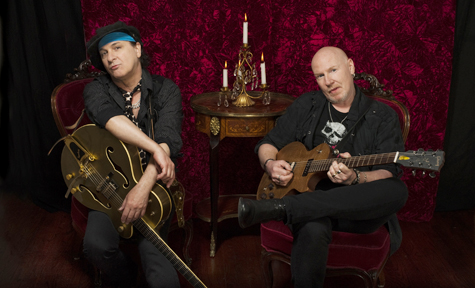
Calling The Batusis a “punk rock supergroup” seems cliché, but it’s accurate. Sylvain Sylvain is the wildly charismatic New York Dolls guitarist and Cheetah Chrome has wielded the axe for Cleveland icons Rocket From the Tombs and Dead Boys. Both of these guys have heavily influenced the direction of punk rock throughout their lengthy careers, but this is the first-ever collaboration between the two longtime friends. In Batusis, the two share guitar duties and take turns on lead vocals. Their self-titled EP, released by Smog Veil Records, is four tracks of loud, brash and fun punk rock, just the way they like it. On the EP Chrome and Sylvain are backed by the rhythm section of Joan Jett’s band, The Blackhearts, but when they hit Sacramento on Oct. 23, 2010 at the Blue Lamp the two will have Lez Warner of The Cult on drums and Sean Koos (who also lends his abilities to The Blackhearts) on bass. Opening this epic night as local punk heroes The Secretions, further solidifying that this is a must-see show. Tickets are $10 in advance and $12 at the door.
Sacramento’s very own CORE Dance Collective is at it again with their newest work entitled The Doorway, an entirely new piece by artistic director Kelli Leighton. CORE’s press release for the event says, “The athletic contemporary and jazz movement is inspired by the unique personality of the different rooms in a Victorian mansion. The Doorway stimulates your eyes and ears and toys with your emotions while you to follow the dark and quirky characters entangled within the house.” In a recent e-mail conversation with Blair Cacanando, CORE’s assistant artistic director, she stated “We keep describing to people that it is going to be an all sensory experience, not just a show in a theater.” Perfect! Not only can you see the dancers’ awe-inspiring performances, you can hear them, feel them even (hey, get your mind out of the gutter, we mean feel them emotionally sick-o). The Doorway will premier at Benvenuti Performing Arts Center, located at 4600 Blackrock Drive in Sacramento, on Oct. 22—23, 2010. There will also be performances the following week on Oct. 29—30, 2010. Tickets are just $15 in advance and $20 at the door, for more information visit www.coredancecollective.org
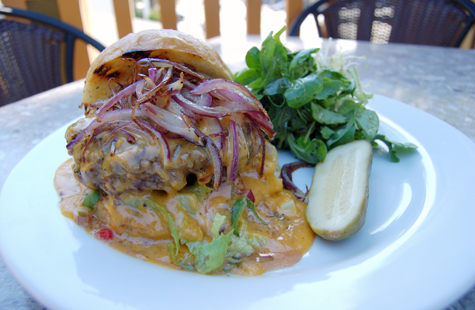
Kupros Bistro
1217 21st Street – Sacramento, Calif.
Words & Photos by Adam Saake
Kupro is Esperantan for copper. If you’re like me, you’re asking yourself, “What the hell is Esperanto?” Esperanto, a language all its own, was developed in the late 1800s as a way to create a middle ground for the people of planet Earth to speak with one another. But it never caught on, and now only a small percentage of people in the world care enough to learn it. Kupros Bistro, a wonderful new gastro-pub located in Midtown, will hopefully not suffer the same fate. If we could draw a comparison, although, it would be that Esperanto is apparently very easy to learn as Kupros’s menu is very easy to love.
What was once a popular costume shop by the name of Cheap Thrills is now a completely remodeled two-story destination for food and libations. Playing off the traditional English pub, Kupros offers a comfort food menu with a touch of finesse. Move over, fish and chips; step aside, bangers and mash–ciao, linguine and clams, bon jour duck confit Rueben.
On my late afternoon visit, the lunch crowd had dispersed and I had the second-story patio all to myself. Inside, a multitude of tables all set and ready to go loomed like a ghost soiree waiting to be possessed. “Banquets,” said my server. Hopefully, because the amount of seating available seemed a little ambitious for what is essentially a pub. Outside, the patio overlooked the busy motorcade that is 21st Street, and umbrellas lined the banister, shading diners from the lingering summer rays and the wind-disturbed pollen and tree debris. Downstairs had booth seating and the U-shaped bar looked very inviting if you like getting friendly with the bartenders. Their draft beer selection had some keepers, including a Belgian-style saison from Lost Abbey and an English-style cider from Fox Barrel. And intentional or not, there was a humorous coupling of Stone’s Arrogant Bastard Ale and Flying Dog’s Raging Bitch.
For the appetizer, I tried the fried pickles ($5) with a house tartar sauce. It’s of note to mention that all Kupros sauces are house-made, all the way down to the ketchup. Four lightly battered and fried wedges of tangy dill pickles are served modestly in a cocktail glass with a napkin back to absorb the excess oil. The tartar is pretty standard, but this dish doesn’t need to reach for the stars; it’s meant as a salty treat to go smashingly with a frosty pint. This isn’t a dish you grow tired of quickly and this is in part to the batter. It isn’t layered on so thick that you have a hard time finding the pickle.
It’s important to order the burger from time to time, because so many places do it differently. You never know when you’re going to stumble upon a truly great rendition of an American classic. As far as Sacramento goes, Kupros’s natural Angus burger with beer cheese, house relish and “drive-thru” dressing ($13) ranks up there in my top three. Aside from a great patty of beef cooked right and a fresh bun, the beer cheese turns this burger from good to great. This fondue-like concoction is a combination of cheddar cheese, lager beer and shallots, which is then smothered over the patty to make for coagulated goodness. Add some grilled onions and you’re dynamite.

I’m a salty and sweet kind of guy, and although dessert at lunch is a little overkill, I just couldn‘t resist. Amongst other interesting treats, Kupros does a vanilla bean panna cotta with chocolate cookies ($8) that have a frosting center (essentially a beefed-up Oreo) made by one of the Kupros pastry chefs, Jodie Chavious. Panna cotta is a traditional Italian custard usually made with cream, milk, sugar and gelatin and the flavors vary from caramel to blackberry. Chef John Gurnee throws a little buttermilk in there to give it a nice tang. This desert is uncomplicated, rich and fun to look at too. Indulge.
The dinner menu has some items not available during the day, including a delicious potted rabbit that I tried on a previous visit that was literally served in a latch-top pot. The kitchen stops serving at 10 p.m., so get your orders in before the night sneaks up on you. Also, Kupros is closed on Mondays and the kitchen takes a little break from 2—3 p.m. so plan accordingly.
Nicatyne MidDay Marauder
The femme-bot voice from A Tribe Called Quest’s classic album Midnight Marauders taught me that seven times out of 10, we listen to our music at night and that “marauder” means someone who loots. Tribe was marauding for listeners. Sacramento’s Nicatyne is out for the remaining 30 percent with MidDay Marauders.
At 21 years old, the Natomas producer-on-the-mic has produced two solo albums, a collaboration album with JoEL and two records with Illecism–both of whom are members of Fly High crew. In a sense, MidDay Marauders is Nicatyne’s sixth record, which is an impressive resume at such a young age. His flow is not as swagged-out as E-40’s braggadocio, but Nicatyne bears some style similarities that make MidDay Marauder feel like shark bites (as in the faux pas of “biting”) on the Bay Area. As Nicatyne states on “12s,” a dedication to 12-inch speakers, there’s only one reason his music has that bass for your trunk: “I knock because I got–12s.”
The album title will feel deceiving, given the young rap community’s recent insistence on reinterpreting the golden age classics (i.e. Fashawn’s Ode to Illmatic). MidDay Marauder is not one of those records.
Nicatyne, like many producers who rhyme, is better at one of his trades–the reason the term “producer-on-the-mic” was coined. Opener “One Morning” is abstract and minimalist with its plumber-banging-on-pipes percussion and dog bark samples, while the East Indian bounce of “Dhalsim” (featuring JoEl) has anthem potential with its “My cash stretch like Dhalsim” chorus chant. Nicatyne’s soft-spoken and nasally flow on “My Way” meshes well with his crawling production that rides a pixie-like vocal sample. Five songs deep into the record, Nicatyne is on a creative tear, but “The Man” disrupts the momentum to a point that the album never recovers its swagger.
Nicatyne lags into whatever rappers are calling the clubby-hyphy style songs these days. Slap? Blap? Someone call it. No matter the slang, I am not ready to accept the track “Deaf Star” and its Comic-Con-meets-night-club format.
MidDay Marauder closes strong with “It’s a Wrap,” which features Illecism, and the barbershop-slap of “Real Banter” is another minimalist banger built around a phrase that might replace “real talk.” The not quite chillwave, not quite R&B production on “Forever” is a close call between lapsing into the corny side of The Dream or the trendy side of Nite Jewel–either way I’ll be answering for that comparison in hell.
I’m still waiting for a Sacramento record that feels as though it was conceived strictly with a Sac-Proper state of mind. An identity crisis is spreading like a plague on the scene. It’s time for a sound to be identified as pure, instead of pandered toward the greater Northern California region.
RJD2 Doing What He Wants to Do
After releasing his debut, Deadringer, in 2002, it was clear that RJD2 was embarking upon a fruitful career of longevity and innovation. The DJ/producer, and later vocalist, had an undeniable vibe and an eclectic palette of sounds at his disposal. With an understanding of music theory and chord progressions, his instrumentals played out more like a score than the average programmed beats, and while it was natural to lump him into the hip-hop gene pool at first, you knew he would eventually go on and grow into his own.
His preceding solo albums showed a quick evolution. As he began shifting further away from his hip-hop base with Since We Last Spoke and The Third Hand, he had group projects with MCs like Blueprint and later Aceyalone that were catered more toward his core. RJ’s output, whether it was his own albums, lending his production to other projects or through a series of mixtapes, remained consistent and always pushed the creative boundaries he had cast on his last.
Complacency is a word that doesn’t exist in RJ’s vocabulary. He is always recording and creating, always touring, and now that he started his own label to back it up he is always working. It’s a job he enjoys though, and one that he is quite good at.
In support of an upcoming stop at the Crocker Art Museum on Oct. 16, 2010 Submerge reached out to the Oregon-born renaissance man. Excited to bring his four turntable and two sampler setup, he talked about the past and present and what to expect in the near future.
I want to talk about the progression of your career. From your early days with MHz on the underground rap tip, to creating what some dubbed as an “indie rock” album, to your last album The Colossus which was a collage of all kinds of genres, you have shown you can do it all. Was it always the plan to be this all-encompassing artist?
No, I never had any kind of any master plan of this is where I want to be in five or 10 years. I’ve just been kind of looking at what’s immediately in front of me, and behind me too, and sort of responding and reacting to those things. One thing that I feel compelled to mention is you brought up the “indie rock” record. I haven’t been working on that in any master plan, but there have been some constants in my career; some common threads that have ran through almost everything that I’ve done. From the beginning of my career to now the most driving influence in everything I do still is soul and R&B music. It has permeated in every record and decision. It’s not conscious or anything, it’s just how it comes out. I know people refer to The Third Hand as more of an indie rock record, and I assume that is because of the singing, but from my perspective if you look at the production and sound of that record, it’s very much drawn from soul, funk and psychedelic rock influences.
Going off what you just said, and I hope this doesn’t come off offensive, but do you think it was labeled that because you are white?
[Laughs] Well, I’ll put it this way… For one, I don’t take that as offensive. I’ll pose a statement to you: A band like TV on the Radio can make a certain type of record, and for better of for worse they are going to get lumped into the category of “black rock.” I don’t know how they feel about it, but I assume a group like that doesn’t really care for that classification. I don’t know, we could play the game of hypothetically speaking thing all day, but to answer the question, it’s entirely possible [laughs]. One thing I will say to play devil’s advocate, I wouldn’t rule out the opinion of it’s how I sang on that record made it feel more like an indie rock singer than, say, a Curtis Mayfield soul record. And you know, to this day I don’t particularly fancy myself as the most accomplished vocalist. On that record, though, it’s not a bravado-heavy style of singing, it’s harmony-dependent. Singing-wise, I can see how people would say it was an indie rock style of vocalization, but to me there is so much more that goes into all music than just who’s singing; it’s the sound of the drums, the production techniques and all that other stuff make up the cumulative effect.
Is it bothersome for someone like yourself who works without boundaries that ultimately it’s the journalists and such who say what each album is? Do you read that stuff and just get a headache?
I learned it doesn’t put me in a healthy place to read reviews of my records. I do everything possible to avoid them actually. Right around the time of The Third Hand is when I learned to disassociate myself from reviews. I vividly remember reading the first two reviews, and they were so wildly disparate it just made me realize it wasn’t making me more effective as a producer, or better yet as a person. The only thing I lament about with the current climate is that it seems we have entered into an arena where the reigns over and the rest follow. It’s funny because I’ve had journalists tell me that other journalists, or magazines and blogs or whatever, wait for the larger source in their field to sort of say what’s good and what’s not, and then everyone else follows suit. As a listener, I don’t think that serves anyone well.
Have you found in the interviews that you do that the level of journalism has dropped?
Yeah, I have found that people are less prepared. A lot of times it seems like I’m answering questions that are straight out of my bio. It doesn’t bother me, but it annoys my publicist the most [laughs]. I’ve gotten used to answering the same questions over and over. But yeah, I have noticed people not doing any research. Again, I’m not reading them, so I don’t see the final product, but the preparation seems to have dropped. There are still a lot of folks writing about stuff that they are interested in, which to me makes the most sense. It seems natural that you would write about the stuff you like opposed to the things you don’t.
OK, fair enough. To switch gears completely, I want to talk about your new label that you created, Electrical Connections, and get your perspective on being an artist/label owner. Was it more work than you expected?
It has been more work than I expected, but not a huge amount. At first it was tough, and I was taking on a lot of things–I reissued three records, put out a box set and released a new album in the course of four months. That period, of what was essentially putting out four records in as many months, was really rough. In hindsight though it’s only about 20 percent more work than what I was used to. I had a small label I was running called Bustown Pride on which I just pressed CDs and sent them straight to the distributors. Honestly, looking at the profit margins and the work that goes into everything, I’m still in awe how any record label can afford to have a staff.
Would you say it was a grueling process with a big reward, a grueling process with little reward, or say a fun process with a great reward?
I would say somewhere between grueling and a tolerable process, with a great reward. The reward for me is ownership of masters, which isn’t always immediately gratifying. It’s basically either going to pay off or not in the future, but I’m still wholeheartedly pleased with the way I’ve gone about it. My biggest concern was that I would put The Colossus out and no one would know anything about it. Love it or hate it, I feel like the visibility is about the same as it has in the past, and that is good enough for me.
With the name Electrical Connections, I have to ask about a video I saw of you where you built a wireless MIDI controller that linked up to your MPC… I gotta say, it was pretty awesome. I know you enjoy building and tweaking your equipment. I wanted to know if you have any other big projects in the works?
[Laughs] Recording-wise yes, I just moved and I set up a new studio space that is much bigger than my previous. The added new space will allow me to have several rooms that are all inter-connected in the house. The ergonomics of doing completely live music, or synth-orientated music, or sample-based music and having each in their own spaces but will all great. It’s all wired into one control room, and I have video and USB feeds going through each room. There are times you don’t want to blend it together, but one of the things I really liked about my last record was having all kinds of themed approaches to recording. I get bored doing the same thing over and over, but I like the idea of doing just sample-based music, but I like to be able to easily blend them. I have a couple records finished that I’m in the process of getting ready to be released. I’m just waiting to get the studio done.
Can you divulge on those?
Yeah, the first one… I’m pretty into horror and sci-fi soundtracks from like the mid-‘70s to like 1984. It’s all instrumental, and sort of an homage to that kind of cinematic approach to scoring music. I also did a record with a group I started with a singer named Aaron Livingston, who is featured on The Colossus. It’s all him singing and me on production, the group is called Ice Bird. Those two will be coming out in the next year for sure, hopefully before that.
And with a little foresight, how will journalists label Ice Bird?
[Laughs] I have no idea. I have proven to be a poor judge of that.
Last one. This interview is in support of your upcoming gig in Sacramento at the Crocker Art Museum. I have a feeling this may be different from a typical club gig you might get on tour, so I’m wondering if or how you change up your set depending on the setting?
I try to stay prepared. In the last year I’ve been using Serato [DJ software], but in the past I had to create dub plates so that I’d have everything for the live show. If I find myself in front of a crowd that doesn’t necessarily know my music, and they just want to hear something else, it’s like an eject button. Depending on the crowd though, I try to keep focused on doing my own thing.

RJD2 will perform as a featured guest at Neo-Crocker 2010: A Modern Culture Party at the Crocker Museum on Oct. 16. The party will run from 8 p.m.—2 a.m. and will also feature performances from DJ Shaun Slaughter, the Sacramento Ballet and much, much more. Tickets are $75 in advance and $90 at the door. For more information, go to www.neocrocker.com.

